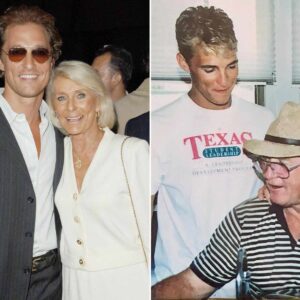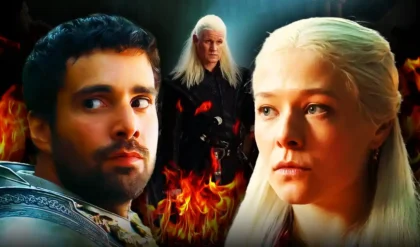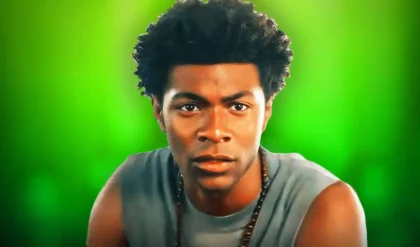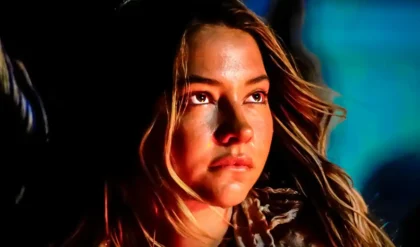The Emmy-nominated actor and prosthetics designer Michael Marino spill secrets behind how they created Wayne Hays, inside and out, from the 1980s through 2015.

Mahershala Ali gives not one, not two, but three riveting performances on season three of HBO’s True Detective as Arkansas state police officer Wayne Hays. Set against an Ozarks backdrop, Hays’ story begins in 1980 as the detective looks into the disappearance of two children. Audiences follow Hays for more than three decades (the ’80s, the ’90s and finally in 2015), witnessing a romance blossom but then a marriage crumble as a career with high hopes also deteriorates.
Ali had been a fan of the HBO drama since season one, but never thought he’d star on it. “When this show came out, I was in a very different place in my career. I literally said, ‘Man, I would love to be on True Detective,'” he tells The Hollywood Reporter. “I’ve been working for 19 years now, so for this to be my first lead for a show, with a writer like Nic Pizzolatto, was a dream come true.” The Emmy nominee (and two-time Oscar winner) spoke to The Hollywood Reporter about how he crafted his character with help from prosthetic makeup designer Michael Marino.
1980s

The start to Wayne Hays’ story was by far Ali’s favorite to settle into. As a 35-year-old black detective for the Arkansas state police with a history of serving as a long-range reconnaissance tracker in Vietnam, Hays has his demons yet still walks into any room with bold confidence.
“What I loved about 1980 was this hope this character had toward love and a life that would potentially be fulfilled and he would be potentially whole,” Ali says. “Whole in a way that he had never imagined himself being.”
While investigating a case involving a pair of missing children with his partner Roland West (Stephen Dorff), Hays is easily pushed to his limits. What centers him amid the chaos is Amelia (Carmen Ejogo), a teacher and aspiring writer.
“This Amelia gave him hope. She was somebody who was aspirational. I don’t think he ever imagined coming across a woman like that in that town,” Ali says.
Though wardrobe and a crisp ’80s haircut were superficial ways to convey age, Ali went much deeper. “I started thinking about the physicality and wanting to adjust my physicality a bit over the course of the years, always trying to be conscious of what he was grappling with, what he was coming out of, what he was dealing with in whatever era,” Ali explains.
“In 1980, I would stand straight up and be confident and really try to be in the fullness of his masculinity,” Ali adds.
The actor also admired his character’s ambition, despite the horrors Hays has seen and the racial injustices he’s endured. Becoming a black state police officer in the early ’80s was no small feat, and the actor made sure to convey that immense pride.
“He’s confident and hard-headed, and the reason he’s able to be a lead detective in the South at that time is because the things that contributed to that confidence were extreme accomplishments for a black man of that era.”
Ali, whose own grandfather was a California state police officer, says the one significant prop he kept was his badge. For him, the symbolism was twofold — a meaningful family connection to this role and the journey he’s taken to get to this point in his career.
1990s

Heading into the ’90s, True Detective finds Wayne, now 45, married to Amelia, who has written a book about the investigation, and still plagued by the unresolved case. A man once so sure of himself is now lost, and not even investigating new details of the case with his old partner can make things right. Hays eventually resigns from the police force, becoming head of campus security at the same university where his wife is a lecturer.
“A lot of the pacing of that character came out of insecurity. [It] was being mindful of his insecurities and trying to get his equilibrium right,” Ali says.
Ali notes that this was by far the most challenging age to play because of the defeated mental state Hays sinks into. “I struggled with that because of where the character was at. He was in this dark, pessimistic place,” he says. “To live for 70 hours, in 1990, in that character, being in such a dark place was really challenging. That space didn’t resonate with me.”To help personify the chipping away of ego, Ali notes that he sped up his speech. “I felt like things would be a little bit more clipped, a little tighter, so I sped up my rhythm a little bit. Also being cognizant of the fact that he was pent up in the ’90s. His career was essentially on the decline and he carried around a lot of tension and anxiety, and so everything was quicker.”
2015

Ali’s transformation from a 45-year-old to a man in his 70s, weighed down by his past and losing touch day by day due to dementia, was a team effort by Ali and his prosthetic makeup designer Michael Marino.
“Our goal is to make everything as realistic as we possibly can to our own human eye, not even considering it’s going to be on film and it’s more forgiving,” Marino tells The Hollywood Reporter of his process for True Detective. “We approach it in a way of, ‘Can we fool the human eye?’ — which is the best camera lens in the world. And if we can do that, ‘Will it hold up on film?’ — which usually it does.”
Marino, who has worked with Ali before on The Place Beyond the Pines, spoke on their close collaboration to ensure his prosthetics “came to life.” “We’re a team, and I am passing the ball to Mahershala and he is running and getting his touchdown,” Marino says. “He really learned the makeup really well once he was in it and could see what it can do, because it doesn’t move with you. There may be certain expressions that may or may not work.”
Using silicone material for the prosthetic, Marino says his “unique formula” helped give the skin a “very specific way of springing back, like real skin.” He also made sure to preserve Ali’s essence while warping him a few decades older.
“You don’t want to cover his face up entirely, otherwise Mahershala is lost,” Marino says. “I think, ‘Where do I really need to put the pieces?’ Even the forehead is so minimal — it was a few sculpted lines that fit in his own creases. I am using as much of him as I can to still get the effect.”
When it came to collaborating with Marino on Hays’ elderly look, Ali says “what was really difficult was the reality of how black people tend to age and just pulling pictures from my family, [to see] how my family ages and what articulates aging through film and television. There has to be significant difference in how we see someone from age 45 to 70.”
 Marino studied photos of Ali’s grandfather, who as a state police officer inspired Ali’s character, for insight into how an aged Ali would appear.
Marino studied photos of Ali’s grandfather, who as a state police officer inspired Ali’s character, for insight into how an aged Ali would appear.
“I was sending Mike pictures of my grandfather, who was 90, and he was a little stumped because my grandfather, you would never think he was 90, you would go, ‘maybe he’s 60,'” says Ali. “He doesn’t have a lot of wrinkles.”
To do a convincing performance of an elderly man with dementia, “I had to allow myself to struggle for my thoughts,” Ali says, adding that this part of his role hit close to home for him. While one of his grandfathers was a California state police officer, his other grandfather lived with dementia.
The actor adds that playing Hays in his 70s was “truly cathartic” because it offered “the opportunity to play someone managing that illness but still having ambition and aspiration … to finish something that he started … someone who was always wrestling with what was morally and ethically correct. I think [that] Wayne was the one I was most nervous about but was by far the most fulfilling and gratifying experience of my career.”
News
*That’s* How They’re Writing Him Off?!? Blue Bloods’ Final Season Sets the Stage For Danny’s Devastating End
Credit: Getty Images All products and services featured are independently chosen by editors. However, Soaps.com may receive a commission on orders placed through its retail links, and the retailer may receive certain auditable data for accounting purposes. With only five more…
Matthew McConaughey honors his late father James with throwback photo: ‘Made men fathers’
Matthew McConaughey took to social media on Sunday to acknowledge Father’s Day. The 52-year-old actor shared a throwback photo with several older men and wrote: ‘made men fathers. #fathersday.’ His dad, James Donald McConaughey, passed away in 1992 when the star…
Who Killed JonBenét Ramsey? Reexamines One of the Biggest Cold Cases in History
On Dec. 26, 1996, John and Patsy Ramsey awoke to a nightmare. Their youngest child, 6-year-old JonBenét Ramsey, was missing, with a chilling ransom note left behind. The day took a devastating turn when John Ramsey discovered JonBenét’s lifeless body…
Allison Janney Says She ‘Threw the Script Across the Room’ for The Diplomat Season 2 Finale
Allison Janney. Photo: Gilbert Flores/Variety via Getty Allison Janney is revealing how she reacted to seeing one specific script for The Diplomat. During an appearance on Jimmy Kimmel Live! on Nov. 4, Janney, 64, explained that when she first read the script for the political thriller’s season…
Inside The Lincoln Lawyer cast’s real-life romances: Manuel Garcia-Rulfo, Neve Campbell, Becki Newton and more
The Lincoln Lawyer promises plenty of drama both in the courtroom and out but offscreen the stars of the show live regular lives with their loved ones. The romantic complexities on the legal Netflix series aren’t reflected in their real-life…
The Ending of ‘The Diplomat’ Season 2, Explained: Breaking Down Who Planned the Attack and the Shocking Death
(Image credit: Courtesy of Netflix) Season 2 of Netflix’s political thriller The Diplomat begins with a bang—literally. Created by The West Wing alum Debora Cahn and starring Keri Russell, the series follows the titular diplomat Kate Wyler (Russell) as she’s appointed ambassador to the United…
End of content
No more pages to load











